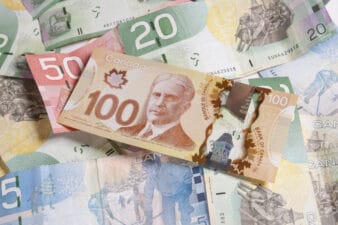Historically, stocks deliver higher returns than interest-producing investments such as GICs and bonds. So, risk-averse investors might decide to hold stocks in a registered retirement savings plan (RRSP) to target higher returns.
Benefits of investing using an RRSP
What’s earned inside an RRSP is tax deferred, whether it’s capital gains or dividends. So, the earlier you invest using RRSPs, the sooner compounding works its magic. Compounding is growing money with money over time.
For example, if you had invested $5,000 in AbbVie Inc. (NYSE:ABBV) in 2013 at about US$42 per share, it would have grown to $7,800 for a total return of 56%. Roughly 44% would be from capital appreciation and 12% would be from dividends. The annualized rate of return would have been 18%.
The $2,800 gains in capital growth and dividends won’t be accessed by the taxman until you withdraw from the RRSP. You can also reinvest the AbbVie dividends you receive for higher returns.
People in high tax brackets particularly love to contribute to an RRSP because doing so can reduce their tax bracket, thereby reducing their taxes for the year.
AbbVie is still inexpensive today. At under US$62, it only trades at 13.6 times its earnings, but it’s forecasted to grow its earnings by about 13% per year in the medium term.
Further, you won’t get the 15% withholding tax on qualified U.S. dividends received in an RRSP. This is another reason to buy and hold quality U.S. dividend-growth stocks in an RRSP.
Since AbbVie was spun off from Abbott Laboratories in early 2013, AbbVie has increased its dividend every year. In fact, it has averaged a dividend-growth rate of 12.5% since the spinoff. Its dividend is 11.8% higher than it was a year ago, and it currently yields 3.7%.
How much can you contribute to an RRSP?
You can only contribute to an RRSP if you’ve earned income. After you file taxes each year, the Canadian Revenue Agency will send you the Notice of Assessment. On it, you can see your RRSP contribution limit. Unused contribution room can be used for future years.
You can open as many RRSPs as you want, but you must keep track of your contributions, so you don’t over contribute because there will be penalties if you do.
You should know…
Investors should be careful to avoid losses in an RRSP because they can’t be used to offset capital gains like they do in a non-registered account.
That’s why it’s particularly important to buy quality companies at reasonable valuations in an RRSP. They should be companies you plan to hold for a long time, so you can ignore short-term volatility. The longer your investment horizon, the more likely your investments will experience gains.
When you withdraw from an RRSP, it becomes a part of your ordinary income, and you’ll be taxed accordingly. In the year you turn 71 years old, you’ll have to terminate your RRSPs. They can then turn into registered retirement income funds (RRIFs) that you can withdraw from.
Conclusion
Once investors learn the ropes of investing in a non-registered account, where they can use capital losses to offset capital gains, investors should consider investing quality stocks at reasonable valuations in an RRSP for tax-deferred compounding growth.
If you invest $5,000 in an RRSP each year for an annualized rate of return of 8%, in 30 years you’ll amass $611,729 (of which, $150,000 is your original savings and $461,729 is growth from your investments).







